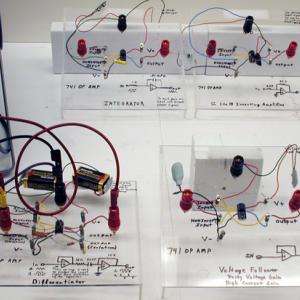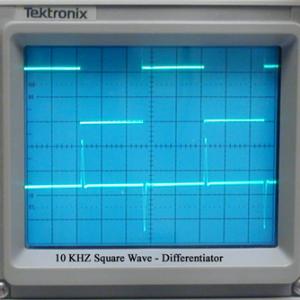College of Liberal Arts & Sciences
5M10.95 - Operational Amplifiers - (Op-amps)
There are 4 made up circuit that are designed around the 741 op-amp chip. They are the 'Voltage Follower', the 'Integrator', the 'Differentiator', and the '1 to 10 Inverting Amplifier'. In each case the power is supplied by two 9 volt batteries. All the ground leads from the wave generator and the two channels of the oscilloscope must be connected to the ground post. The wave generator input and channel 1 (the reference) of the oscilloscope must be in the input post. Channel 2 of the oscilloscope is then connected to the output post. The wave generator can be set to the sine wave function for both the 'Voltage Follower' and the '1 to 10 Inverting Amplifier'. The 'Integrator needs a square wave input. A square wave and a triangular wave are both used in the 'Differentiator' to show what happens to the waveform.
- Victor E. Henrich, "Gravitational Model of a p-n Junction", TPT, Vol. 56, #8, Nov. 2018, p. 538.
- Samuel Derman and Wallace T. Anderson, "Semiconductor Reliability - Another Field for Physicists", TPT, Vol. 32, #4, Apr. 1994, p. 226.
- George T. Gilles, "Commutativity of Elementary Functions Involving Operational Amplifiers", TPT, Vol. 25, #1, Jan. 1987, p. 38.
- Walter Connolly, "Measurements and Demonstrations with an Operational Amplifier",TPT, Vol. 23, #7, Oct. 1985, p. 448.
- Dennis Hite, Timothy B. Boykin, Nagendra Singh, and Dashen Shen, "A Simple Fermi-Dirac Integrating Circuit", AJP, Vol. 73, #9, Sept. 2005, p. 856.
- Martin K. Albert, Howard C. Hayden, "Electronic Integrator for Physics Experiments", AJP, Vol. 54, #8, Aug. 1986, p. 720.
- H. M. Simpson, M. T. Matosky, "Simple Wide Ranging Digital Integrator", AJP, Vol. 54, #1, Jan. 1986, p. 88.
- P. P. Ong and S. H. Tang, "Fourier Analysis with Lissajous Figures", AJP, Vol. 53, #3, Mar. 1985, p. 252.
- E. Mathieson, "Integration with Operational Amplifiers", AJP, Vol. 40, #4, Apr. 1972, p. 638.
- Dave Blackman, "Operational Amplifiers: The Cheap Alternative to Digital Computers", PIRA Newsletter, Vol. 3, #10, March 8, 1989, p. 6.
- Dave Blackman, "OP Amp Circuits", PIRA Newsletter, Vol. 3, #9, January 29, 1989, p. 6.
- Dave Blackman, "The Operational Amplifier", PIRA Newsletter, Vol. 3, #8, December 21, 1988, p. 5.
- C. L. Strong, "The Amateur Scientist", Scientific American, Vol. 224, # 1, Jan. 1971, p. 110.
- Keithley Instruments, "Electrical Engineering Experiment # 3: Linear Op Amp Circuits", Series I.
- Forrest M. Mims III, "Inverting Amplifier, Non-Inverting Amplifier, Voltage to Current Converter, Current to Voltage Converter, Inverting Comparator, Non-Inverting Comparator, Window Comparator Circuits", Vol. IV - Electronic Formulas, Symbols & Circuits, p. 42
Disclaimer: These demonstrations are provided only for illustrative use by persons affiliated with The University of Iowa and only under the direction of a trained instructor or physicist. The University of Iowa is not responsible for demonstrations performed by those using their own equipment or who choose to use this reference material for their own purpose. The demonstrations included here are within the public domain and can be found in materials contained in libraries, bookstores, and through electronic sources. Performing all or any portion of any of these demonstrations, with or without revisions not depicted here entails inherent risks. These risks include, without limitation, bodily injury (and possibly death), including risks to health that may be temporary or permanent and that may exacerbate a pre-existing medical condition; and property loss or damage. Anyone performing any part of these demonstrations, even with revisions, knowingly and voluntarily assumes all risks associated with them.


